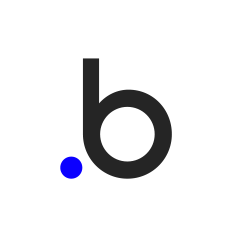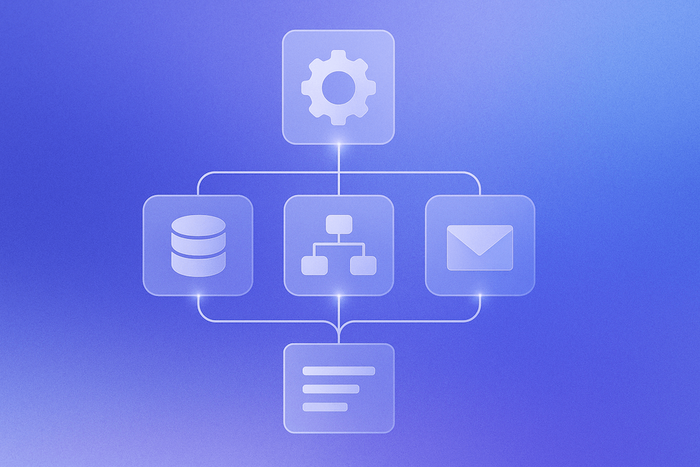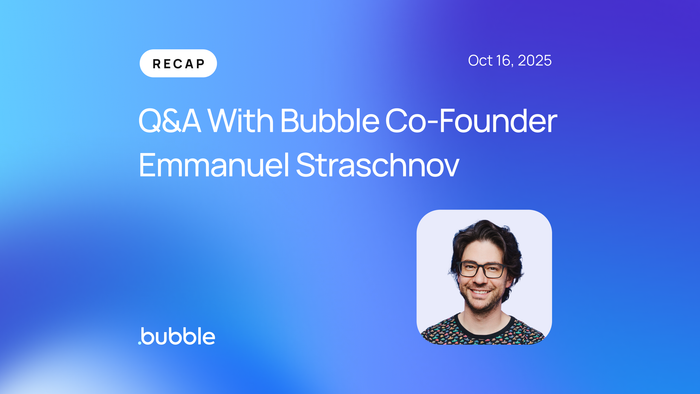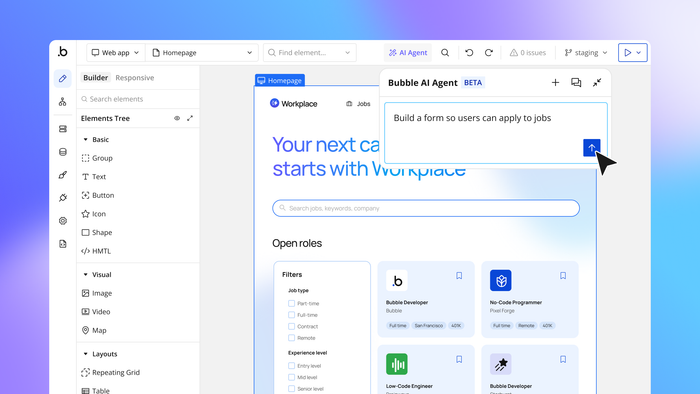The AI app builder space is changing and developing quickly, with new features and platforms available seemingly every week. So how do you know which tool is right for you? We put the most popular tools to the test to see how they stack up. In this comparison, we tested out three platforms: Cursor, Bolt, and Bubble.
Cursor is an AI-powered code editor that allows developers to code faster and speed up workflows with built-in AI assistance. It relies on the developer’s knowledge to guide the process, with the AI as an assistant.
Bolt offers a combination of AI-generated code alongside an editor for traditional coding. It’s code-first and not geared toward beginners, but it is designed to help people build complete apps, not just code — and it offers more support to non-coders than Cursor does.
Bubble is a full-stack, AI visual development platform that combines the power of AI and no-code to give everyone the tools to build and launch fully functional apps. Bubble goes beyond writing the code for your app and gives you an “all-in-one” place to build, launch, and scale a business with strong security, collaboration features, and built-in databases, hosting, integrations, and design tools.
For a deep dive into these platforms one-on-one, check out our other comparisons:
Cursor vs. Bolt vs. Bubble: Three distinct approaches to AI app development
The hype around AI coding tools for building software is real — and yet, most of these tools work quite differently and integrate AI in different ways. A car, a train, and an airplane can all get you to the same destination, but with distinct pros and cons. The same is true for different AI app builders.
Cursor, Bolt, and Bubble all fall along a spectrum of code usage and technical ability.
On one end, you have Cursor. It’s a developer-first platform focused on editing code with deeply integrated AI. It requires a lot of technical expertise and takes a code-forward approach. It’s similar to taking a car for your vacation. You’ll need to map out the whole road trip yourself and drive yourself the whole way — which means you need to feel confident planning the entire journey and know how to drive. Cursor requires coding knowledge and technical experience with the software development process.
Bolt is more in the middle: It takes a code-forward approach, but requires less technical expertise compared to Cursor. Bolt’s workflow, user interface, and resources are all easier to use for those without coding experience. If you’re thinking in traveling terms, Bolt is like taking a train. You get to see some sights along the way, but you don’t have to drive the entire time. It’s easier to use without technical experience, but it takes a similar approach.
On the other end of the spectrum, you have Bubble. Bubble integrates AI capabilities into a full-stack, no-code visual development platform. It doesn’t require technical expertise and takes a visual approach. Bubble is like taking an airplane — you get to spend less time on the journey in favor of getting to your destination as efficiently and powerfully as possible. You’re not getting bogged down in the details of every mile between you and your destination, and you don’t have to have a driver’s license.
In this article, we break down how these different approaches influence app development so you can choose the right AI tool for your next project.
App development workflow
Considering how you’ll actually go about developing an app in different tools is a key element of finding the best option for you.
Cursor and Bolt both take a code-first approach to app development, while Bubble is a form of visual programming. In brief, here’s how that impacts the process:
| Cursor | Bolt | Bubble | |
|---|---|---|---|
|
Guidance for creating v1 of your app |
❌ |
✅ |
✅ |
|
AI can create v1 of your app |
Possible with some direction |
✅ |
✅ |
|
Full-stack capabilities |
For code editing only, no database or frontend |
No built-in backend, and relies on APIs and integrations to build fully-functional apps |
Full-stack with design, data, and logic — everything you need built-in |
|
Visual preview of your app available |
❌ |
✅ |
✅ |
|
Click-to-edit visual development |
❌ |
❌ |
✅ |
|
Full customization available |
Yes, through code |
Yes, through code |
Yes, with code or visual programming |
On Cursor, you start with a blank page, which can be a bit daunting. Once you set up a folder for your application code to live on your computer, you can start writing or generating code.
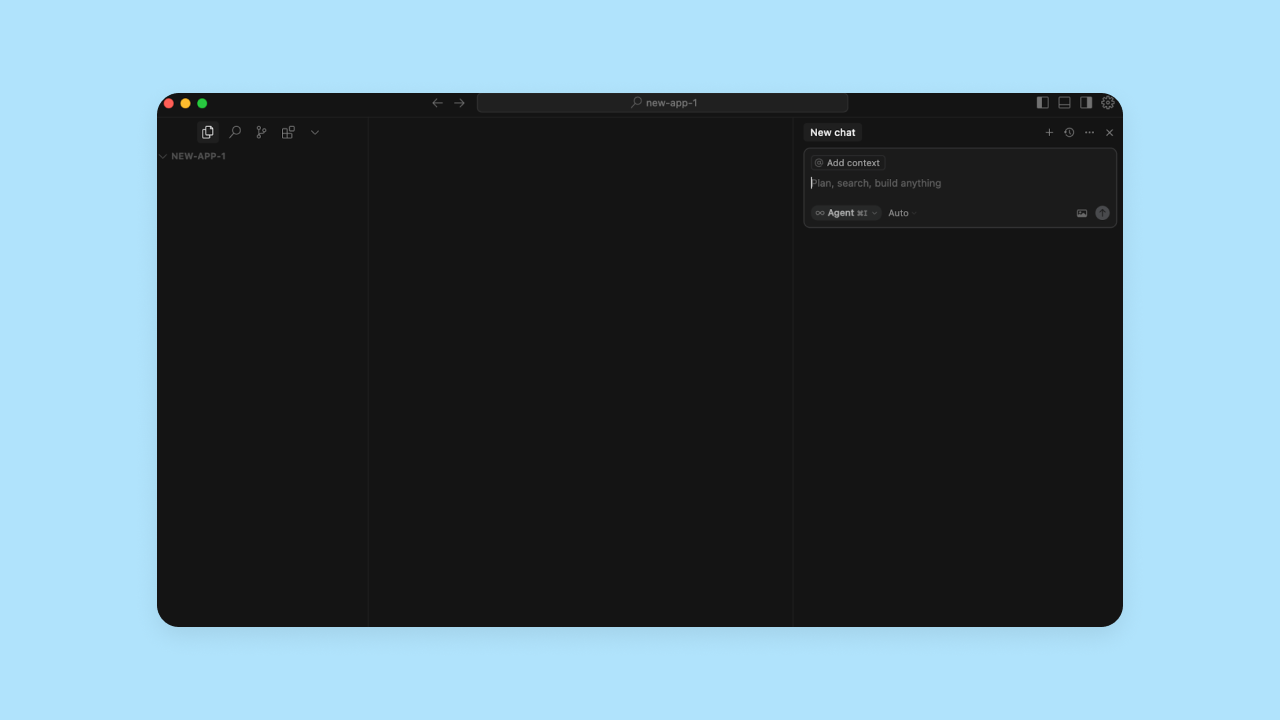
The entire codebase will be accessible on the left-hand side of the editor, and the AI chat interface on the right-hand side. Since Cursor is a desktop program, you’ll also need to download and run the relevant components and dependencies on your computer to give Cursor everything it needs (i.e., Node.js, MongoDB). The AI agent can help walk you through this. You can use Cursor for code generation, but in our testing, we noticed that Cursor expected a lot more hand-holding to create functional apps. For example, the initial code it created was very incomplete, and we often had to prompt it to find and create missing pieces or elements to make the app actually viewable.

Bolt’s UI is a lot more user-friendly for beginners, and offers a lot more guidance than Cursor (which expects you to know what you’re doing). On Bolt, you’ll start by prompting the AI with your app idea. It’ll start spinning up v1 immediately. You’ll see Bolt’s AI agent working on the left, and the code on the right. Once the code is finished generating, you can also choose a visual preview option, which makes it easier to see and test your app’s output.
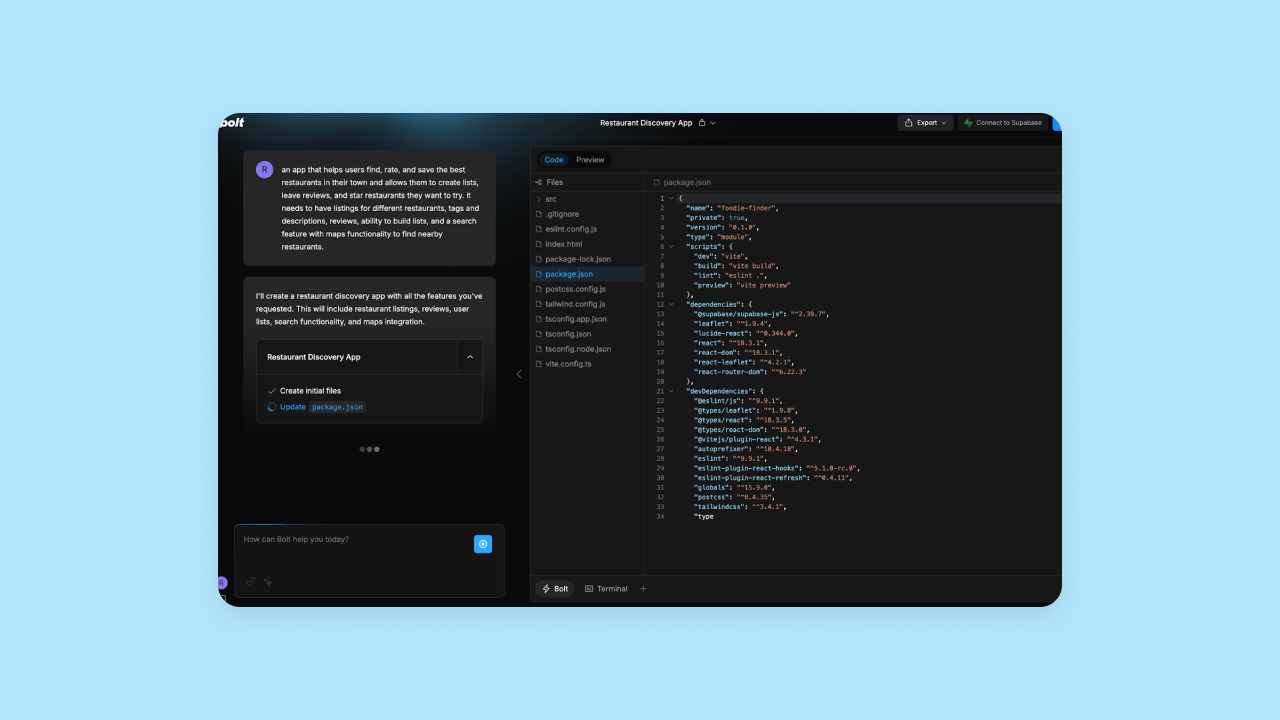
Once your app is created, you can edit the code manually and see the updates in the preview. You can also use the AI chat to prompt for iterations.
One major downside to Bolt is that we hit AI rate limits really quickly, which prevented us from making further changes through the AI chat (a major roadblock for non-coders). On one of our tests, Bolt’s platform didn’t even finish generating the code and app preview before we hit the rate limit.
Cursor has AI limits, too, but they’re sorted by model. On Cursor, you have limited access to premium models and “fast” responses on lower tiers, but you can still use the AI chat. On Bolt, you’re limited to 150,000 tokens per day (it’s not clear how many tokens each prompt will use).
Bubble takes a different approach altogether: You start by prompting the AI, as with Bolt. The AI confirms desired features and creates v1 of your app, then brings you to a visual editor instead of code.
Bubble’s drag-and-drop style editor gives you a totally different way to build and edit your app. Instead of working with code (either directly or through AI chat), you can simply click the elements you want to change or add functionality to, and use visual menus to make changes to how elements look, function, and connect to other elements.

Bubble’s process is the most accessible for non-coders, since it doesn’t require you to interact directly with the code to have full control over design, data, and functionality. And soon, Bubble will have chat-based iteration as well, meaning you’ll be able to ask the AI assistant to make changes to your app for you. An added bonus: Bubble’s AI will show you how it made changes visually (and why), so you know what’s going on and can continue to iterate on your app in a way you fully understand. Bolt and Cursor both require you to interact with code, even if it’s intermediated by an AI agent.
Better yet, Bubble provides everything you need to build a functional app (databases, security checks, etc.) built in to the platform — Bolt and Cursor require you to set these up manually.
Building on Bubble also makes the long-term management of your app much easier — and if you’re used to working with code, you know how big of a deal this is. You don’t have to worry about managing servers, balancing loads, or all of the other technical details that can slow down iteration. Build, ship, and grow with a drag-and-drop editor that gives you all the power of code, without the tedious work of writing every element line-by-line. Plus, you always have the option of adding custom code if and when you want to for the best of both worlds.
Design capabilities
Considering the design-specific tools each platform provides gives you an idea of how easily you’ll be able to build a beautiful, aesthetic app.
Bolt and Cursor both take a code-first approach to design. This means you have full control of your design through traditional coding — which can be a pro or a con, depending on your experience. You can make design changes manually, or you can prompt the AI to help you change the look and feel of your app. Bubble offers a more visual approach, with an editor that gives you flexibility and control over every pixel without having to code. Some specific design elements to consider:
Visual previews and editing
- Bolt offers the option to preview your app visually within the Bolt editor, which makes it much easier for non-coders to see the effects of their changes and isolate specific code to change.
- Cursor doesn’t have a visual preview, which can mean you’re flying blind on design.
- Bubble’s visual editing is a major differentiator compared to other AI app builders. Drag and drop to add or edit UI elements, set manual breakpoints and layouts, design responsively, and make customizations exactly how you imagined them. All of this can be accomplished without code, which makes it much easier and faster to get to the exact design you’re looking for.
Figma integration
- Bolt has a direct Figma integration that allows you to import Figma designs for the AI to “read” and (attempt to) convert into code for your app’s design. We had mixed experiences with this, but overall, Bolt’s AI was pretty good at integrating design-focused changes.
- Cursor doesn’t have a direct Figma-to-code integration, but you can use third-party extensions to convert Figma designs into HTML or React, and then import that code into your Cursor projects.
- Bubble’s Figma integration lets you import Figma files directly into Bubble, which will be automatically converted to pages in the Bubble editor — ready for drag-and-drop iteration and the option to add functionality.
Design systems
- In Bolt and Cursor, you can set up documentation for the AI to draw from, but setting up design systems within the app itself relies on traditional code.
- Bubble lets you easily set up a complete design system within the editor, with reusable UI components and styles you can apply to multiple elements, pages, or across your entire app. This makes it effortless to apply consistent design choices to your entire app, rather than having to code each element’s design from scratch. Even better: If you generate v1 of your app with Bubble’s AI, the AI will automatically create styles and stick to them. (You can, of course, edit the styles manually, too.)
All three apps offer full design customization, but Bubble’s visual approach is a much more manageable way to design your app, particularly for non-coders.
Collaboration
Built-in collaboration tools in your platform can also really affect the speed at which you build — and make the process a lot easier. If you’re the only one who can work on your app, or if you need to create branches and GitHub repositories and add in other tools to collaborate, it can be a lot harder to manage collaboration.
Bubble and Bolt both offer collaboration features natively; Cursor doesn’t (but there are workarounds).
On Cursor, to collaborate with other team members on the same code, you’ll need to integrate and use third-party tools like Open Collaboration Tools. These tools can be integrated into your editing environment so you can live-share and work together on the code. However, Cursor doesn’t offer any built-in collaboration tools.
Bolt offers a Team plan with some collaboration features, with additional costs for AI token rates. Your team members can collaborate on private projects, collections, and connected GitHub repositories. Free team members can collaborate on public projects.
Bubble’s Growth plan and higher also allow real-time collaboration directly within the Bubble editor, eliminating the need for branching or using multiple tools to work on your projects with your team. It also offers the most customizable access permissions, allowing you to control edit access for different spaces (like UI vs. databases).
Security and compliance
If you’re just working on code, you may not need enterprise-grade security. But if you’re looking to build, launch, and scale an app and a business, you need security and compliance that can keep your data and your end-users’ data safe.
It’s possible to build a secure app on any of these platforms, however, they each provide a different level of security built into the platform. On Cursor and Bolt, most of the security settings are up to you as you build. That is, you need to know what to build to make your app secure, and how to do it. On Bubble, there are a lot more handholds and automatic security scanning in place to help you build a secure app, even if you’re not familiar with the process.
Here are some specific factors that might be important for your project, and how each platform stacks up:
Compliance. Building on a compliant platform protects your code and your app. If you’re building enterprise products or building a project you want to use for your business, compliance certifications are important to consider.
- Bubble and Cursor are both SOC 2 Type II compliant; Bolt is not.
- Bubble also meets GDPR standards and provides enterprise-grade infrastructure (AWS) and data encryption (HTTPS with SSL encryption and encrypted at rest with AES-256 via AWS RDS).
- Cursor also has some enterprise-level security standards, which are outlined in detail in their security documentation.
App-level security. App-level security helps ensure your end-user data is encrypted and protected, and helps avoid security vulnerabilities in your app’s code and structure. This is a must for every app with end users!
- Bolt doesn’t manage databases for your app (where your end user data is stored), so it doesn’t have any built-in security. You’ll need to both build a secure app at the code level and make sure you’re working with a secure database platform, like Supabase. AI-generated code isn’t secure by default, so you’ll need to be familiar with app privacy and security settings to be able to double-check the AI’s work.
- Cursor also doesn’t manage databases or hosting — only code. You don’t have any built-in security or privacy at the code level, so you need to be familiar with those requirements on your own and maintain full responsibility for creating a secure app.
- Bubble allows you to use the visual editor to set up app-level privacy rules and restrictions, so you get full control over security for your app without having to learn how to code it manually. Privacy rules aren’t set up automatically, but Bubble will guide you through it to make sure you have a secure app.
Bubble also has a number of built-in security tools via Flusk to give you the option of running automated security checks. This way, you get automatic scans of your app for potential vulnerabilities and alerts of any potential problems. Other built-in security features include:
- Built-in user authentication with options for 2FA, SSO, and more.
- Vulnerability testing
- DDoS protection and Cloudflare blocking to prevent attacks
Plus, Bubble has a strong, established track record of hosting and maintaining apps with thousands of users around the world — a testament to Bubble’s security, stability, and production-grade environment.
Framework support
A “framework” is a kind of code library that provides pre-built bits of code in a certain programming language. For example, the Angular framework provides some reusable UI components and pre-built workflows for common tasks for the TypeScript/JavaScript language.
If your team needs to use a certain language — due to internal knowledge, tech stacks, or other constraints — it’s important to consider which platforms will support that. If you’re not tied to a specific programming language, then framework support is less relevant for your project.
Cursor supports any programming language, giving developers tons of flexibility. It works best with Python and JavaScript / TypeScript due to its training data. To make Cursor stronger with any programming language, just add relevant documentation to your project to give it more context.
Bolt provides a lot of framework support, too, though not quite as varied as Cursor. Bolt primarily supports JavaScript/TypeScript, React, Vue, Angular, Svelte, Astro, Tailwind CSS, and ShadCN. Notably, Bolt doesn’t support Python, C#, or C++.
Bubble works with a unique visual programming language specific to the Bubble platform. When you build on Bubble, you work within an all-in-one system that doesn’t require you to learn or know any specific programming language. If you want to add custom code, you can do so — but you don’t have to.
Integrations
Plugins and integrations connect both the platform you’re building on or the app you’re building with other technology. This allows you to create a fully-functional app that integrates your entire tech stack seamlessly and expands the capabilities of your app.
For example, you might want to integrate Stripe to collect payments or Slack to allow users to send reminders directly from your app to their Slack channels.
Cursor doesn’t offer any built-in integrations. As with many aspects of the platform, you’ll need to build them yourself in the code. They do offer some documentation for using custom API keys with other LLMs to get more AI assistance as you code, but for building and maintaining integrations to other platforms, you’ll need to code those manually.
Bolt offers a limited library of pre-built, expertly-maintained integrations. These include Supabase and Firebase for databases, Netlify for deployment, and GitHub, GrokAI, Gemini, and ElevenLabs API. If you want integrations beyond these, you’ll have to code your own — and you’ll be on the hook for maintaining it as well.
Bubble offers the largest integration library by far, with thousands of pre-built and expertly-maintained integrations available to add to your app with just a click. Bubble’s most popular integrations include:
- OpenAI and ChatGPT 4
- Anthropic Claude AI
- DALL-E
- GitHub
- Figma
- Stripe
- Paypal
- Google Suite products
- and thousands more
If by chance you want to connect your app to something Bubble doesn’t already have a plugin for, you can use our API connector to easily build your own integrations without coding, or code your own manually.
Hosting and deployment
When you’re ready to get your app live for end-users, you’ll need to find a hosting provider (somewhere for it to live online) and deploy it (launch it on that server). When the deployment and hosting process is simple, it makes it a lot easier to get your app up and running — and streamlines future updates and iterations too.
Cursor doesn’t manage hosting or deployment. As discussed, Cursor is purely a code editor. Once your code is ready to go, you’ll need to set up hosting separately and migrate the code to deploy and launch. For example, you could use a Vercel to deploy your app, by migrating your Cursor code to GitHub and then connecting your GitHub repository to Vercel for hosting. There are lots of other options as well, but the end result is that you need to manage hosting and deployment on your own.
Bolt supports deployment, but doesn’t offer hosting. Bolt partners with Netlify to host your app. You’ll set up a separate account with Netlify, then use Bolt’s “one-click” process to deploy your app, and then bounce back to Netlify to “claim” that URL and add it to your Netlify account. You’ll need to manage both your Netlify and Bolt accounts, but it’s still a fairly straightforward process.
Bubble offers the most streamlined process with built-in deployment and hosting. Bubble servers can host your app, so going live is truly a one-click process, and you get to keep everything in one place. You only need to juggle — and pay for — one platform, and pushing future updates and iterations live is as simple as clicking a button.
Required technical expertise
Finally, a big factor to consider is your own experience and technical expertise. While AI makes it much easier for beginners to interact with and build software using code, it’s not (yet) an effortless collaboration.
As you’ve likely gathered from the article already, these tools span a range of technical expertise. Cursor expects and requires the highest level of technical experience, Bubble requires the least, and Bolt is in the middle.
Cursor is a developer-first tool that primarily works with code. It uses a traditional development environment and editor, and doesn’t have any visual output, preview, or editor. You’ll need to understand and feel comfortable with code to use Cursor effectively.
Although you can absolutely use Cursor’s AI to help you generate and iterate code, the output and editing is all text-based. So you still need to be able to understand what code is being created, what code your project needs, how to structure and secure your app, and so on. If you’re not a coder, Cursor gives you AI support, but you’re still going to find a steeper learning curve and will find yourself getting stuck quickly when the AI does.
Bolt also targets developers and is a code-first tool, though the interface (aka the editor) and the AI are slightly easier to use for non-coders. Bolt also provides a bit more documentation and support for non-developers. However, the Bolt team recommends that builders understand or learn the basics of coding first to get the most out of the tool — and we’d have to agree. To build anything beyond the basics, you’ll need to know and use some coding skills.
Of these three, Bubble is the only one that offers a true no-code experience, supported by AI. Instead of assuming that you’ll be able to “speak” a programming language, the Bubble editor speaks your language by “translating” everything immediately into a visual format — and letting you work visually as well. This makes the platform much more intuitive and accessible to non-developers, without sacrificing customization or control. You never have to learn or use code, like you do with Bolt or Cursor.
Bubble’s codeless editor also eliminates the problem of AI prompt loops that are common with non-coders using Cursor or Bolt. Instead of endlessly prompting the AI but not getting exactly the results you want — or not even knowing if you’re getting the results you want — you have full control visually, allowing you to work with no-code all the way to launch and beyond.
Not to mention that Bubble’s full-stack, all-in-one platform makes it much easier to do all the tangential things that come with building and launching an app. It doesn’t just support you in writing the code — it also gives you a built-in database, strong security, built-in hosting and deployment, collaboration, and more. Bubble also offers resources and education for all skill levels, from true beginners to experienced developers, to help you get the most from the platform, faster.
Which AI builder is right for you?
When comparing these platforms, considering your technical experience, how you want to work with AI, and your desired workflow will help you choose the right option.
Cursor is a great choice for experienced developers who want to speed up their existing workflows with AI support as they code. When you already have an existing tech stack, familiar programming languages, and strong expertise, Cursor gives you a way to isolate a time-consuming step of the software development process — writing and debugging code — and speed it up with an AI co-pilot.
Bolt is also best suited for experienced developers, but it provides more support for the entire app-building process, not just writing code. It allows you to easily spin up v1 with AI and keep your AI assistant involved at every step for rapid prototyping or to eliminate the more tedious parts of coding and development. It can also be a useful tool or a coach for beginner developers who are looking for support learning code or new frameworks. Bolt’s limited free plan also means it’s better for traditional development teams who have budgets for higher-tier plans.
Bubble is the only AI-powered platform that offers true no-code, visual development built for you (and your business) to grow. Bolt and Cursor make it easy to generate code, while Bubble’s “out-of-the-box” experience makes it easy to build a business. Instead of just speeding up traditional coding workflows, Bubble disrupts the old model altogether, creating a fully visual approach that’s accessible to both developers and non-developers. With Bubble, you can use AI to generate (and, soon, edit) an app you understand — not just code you don’t.
This allows anyone to create production-grade apps and full-stack enterprise software to launch and grow with speed, scalability, and full control. And you never have to code or leverage a technical background.
Of course, the best way to see if Bubble will work for your project is to test it out for yourself. Try our AI app generator today for free and see how fast you can get your ideas into a real-life product.
Build your app on Bubble's Free plan. No need to upgrade until you're ready to launch your app.
Join building